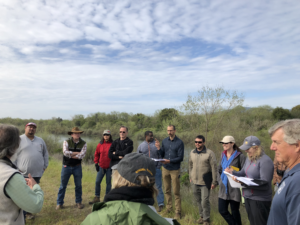 After 11 years of hard work, changing design firms, navigating changes in property ownership, and countless other hurdles, this important restoration project submitted permit applications for construction permits to Sonoma County. A major milestone!
After 11 years of hard work, changing design firms, navigating changes in property ownership, and countless other hurdles, this important restoration project submitted permit applications for construction permits to Sonoma County. A major milestone!
The Hanson Floodplain Restoration, spanning 360 acres west of Windsor will convert four gravel pits back into a historic habitat of seasonal wetlands. This will eliminate the current negative impacts of the site’s present status. Today this site adds more mercury pollution to local fish, birds, and other wildlife. Juvenile salmon are often stranded and consumed after floods and the unnatural ponds left behind heat up the temperature which can spur toxic algal blooms.
This project will move over 4 million yards of soil on-site, with the goal of elevating to raise the bottom of the pits and connect the resulting lowered floodplain area to seasonal wetlands that once existed. This conversion will eliminate mercury contamination, increase groundwater recharge, sequester polluting fine sediment from the river, and provide abundant food for juvenile salmon in low-velocity off-channel waters. By giving the river more room, the project will reduce channel velocities and resulting bank erosion which is currently a major problem in this reach. After the restoration work is complete, the property will become a county park with walking trails and a boat-in and group campground so you can enjoy this restored property and its wildlife.
Reaching this point has been an extensive journey. Our design team has had to start from scratch, as there is no template for this major land conversion. In the middle of the process, our lead designer departed from her firm, prompting us to transition to a new design firm. We were fortunate to secure the expertise of GHD, along with the leadership of project manager, Jeremy Shelva. Two years ago, Hanson Aggregates underwent a change in ownership, being acquired by Martin Marietta on the East Coast. Fortunately, the new owners have demonstrated a commitment to the project, aligning with the vision of their predecessors. Achieving this milestone required the securement of permits from six state and five federal agencies in addition to Sonoma County, which has entailed numerous regulatory coordination meetings.
As the permit process at the County and regulatory agencies moves ahead, the project team is actively looking ahead in strategizing management construction contracts and schedules. We’re also talking to state and foundation funders to build interest in supporting the project financially as it will likely cost over $30 million dollars. We hope to be able to offer site tours in 2024 so you can see the project firsthand and learn more about this exciting opportunity to restore the functionality of our river and better help our community prepare for climate change.
